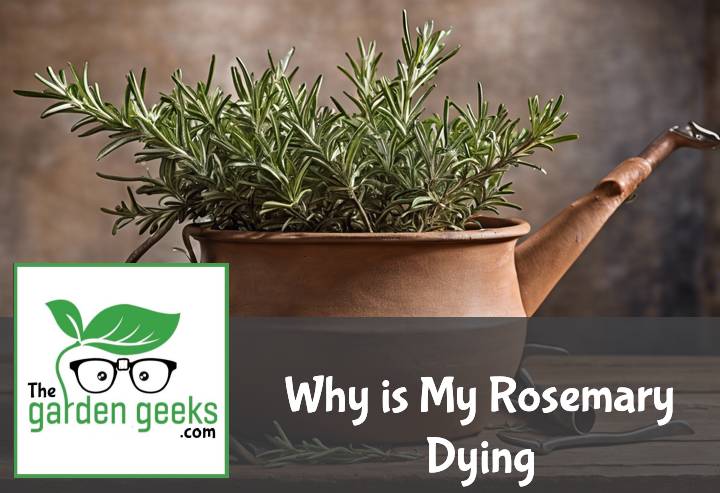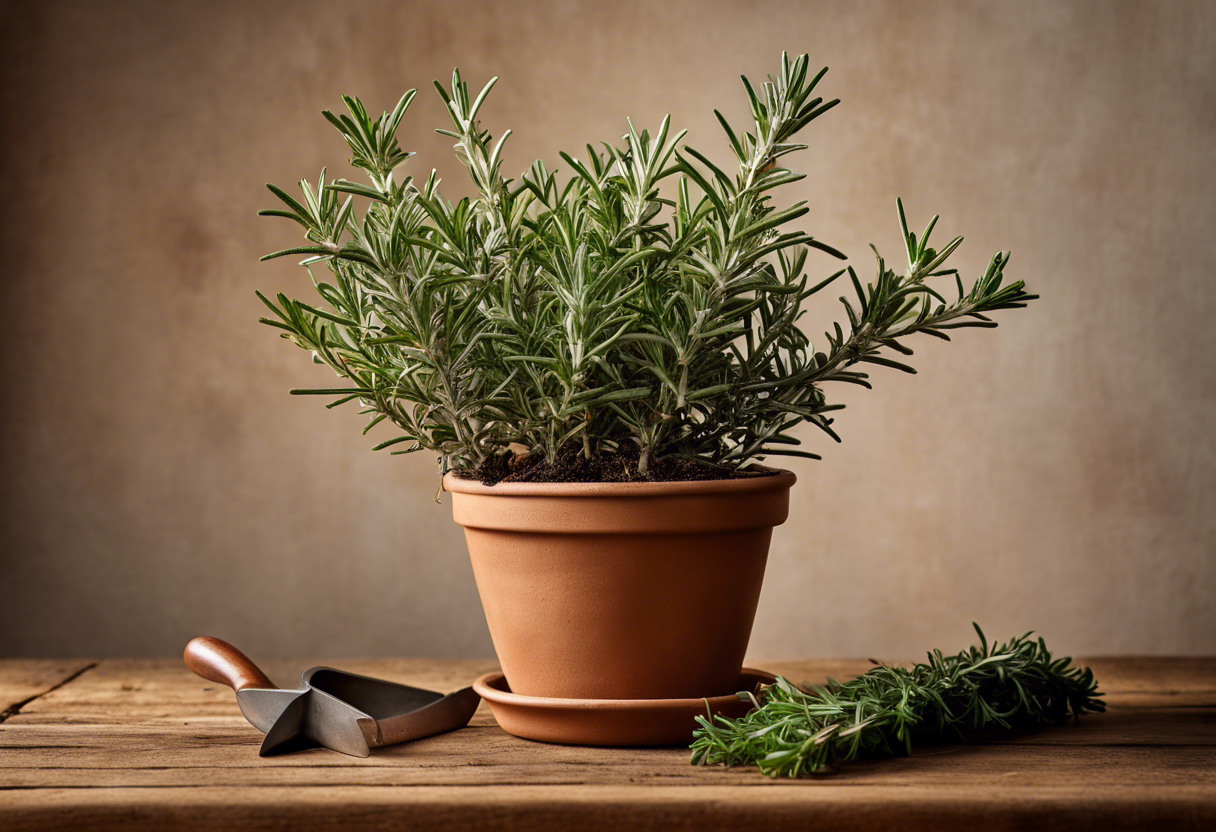Ever had those moments where you look at your once vibrant rosemary plant, and it’s looking a little…well, less than lively? You’re left scratching your head, wondering Why is My Rosemary Dying? Trust me; I’ve been there.
In this blog post, we’ll dive into the common reasons why your beloved herb might be on its last legs (or should I say roots?) and more importantly, how to bring it back to life! So buckle up, and let’s save some rosemary plants!
Key Takeaways
- Rosemary plants may be dying due to overwatering, underwatering, insufficient sunlight, poor soil conditions, or diseases like root rot.
- Overwatering can cause yellow leaves and root rot. Water only when the top inch of soil is dry.
- Underwatering leads to wilting and browning. Ensure consistent moisture without waterlogging.
- Rosemary needs 6-8 hours of full sun daily. Lack of sunlight causes leggy growth and fewer leaves.
- Use well-draining soil with a pH between 6.0 and 7.0.
- Treat diseases with appropriate fungicides or by removing affected parts.
Understanding Rosemary Plant
Ah, the rosemary plant! A favorite in many gardens and kitchens. This aromatic herb is not just a culinary delight but also a visual treat with its needle-like leaves and blue flowers. But why is my rosemary dying? To answer that, we first need to understand the rosemary plant characteristics and the importance of rosemary.
What is a Rosemary Plant?
The rosemary plant, folks, is an evergreen shrub native to the Mediterranean region. It’s loved for its fragrant leaves that are often used in cooking. You might have seen it jazzing up your roast chicken or potatoes. But beyond its culinary uses, it has some serious health benefits too! The benefits of rosemary include improving digestion, enhancing memory and concentration, and even reducing stress. So you see why it’s so heartbreaking when our beloved rosemary starts wilting away.
Ideal Conditions for Rosemary Growth
Now let’s talk about what makes this green beauty tick. The optimal environment for rosemary includes plenty of sunlight, well-drained soil, and not too much water. Yes, you heard right! Unlike your needy ex-boyfriend or girlfriend who demanded constant attention, rosemary likes to be left alone sometimes.
Rosemary loves basking in the sun; it needs at least six hours of direct sunlight each day. As for soil type – think beach holiday! Sandy soils work best for this Mediterranean native. And remember folks – don’t overwater! Waterlogged roots are a big no-no for this drought-tolerant plant.
So there you have it – the basics of keeping your rosemary happy and thriving. Keep these tips in mind next time you wonder “why is my rosemary dying?“.
Common Reasons Why Your Rosemary Might Be Dying
Ever wondered, “Why is My Rosemary Dying?” Well, it could be due to a number of reasons. Overwatering or underwatering, lack of sunlight, poor soil quality and incorrect temperature conditions are the usual suspects.
Overwatering or Underwatering
When it comes to watering your rosemary plant, finding the Goldilocks zone is key. Too much water can lead to root rot – a common problem with rosemary. On the flip side, too little water can leave your plant parched and wilting.
Overwatered rosemary symptoms include yellow leaves and a droopy appearance. If you’re guilty of overwatering, don’t panic! Just let the soil dry out before you water again.
Underwatered rosemary signs are slightly different. You might notice brown tips on the leaves and an overall lackluster look. If this is the case, increase your watering frequency but remember – moderation is key!
Lack of Sunlight
Sunlight plays a huge role in maintaining healthy rosemary plants. Without enough light, your plant may become leggy and weak.
If you notice pale leaves or slow growth, these could be signs that your rosemary needs more light. The solution? Move your plant to a sunnier spot!
Rosemary plants love sunlight and need at least six hours of direct light each day. So make sure they get their daily dose of vitamin D!
Poor Soil Quality
Poor soil quality can also answer the question: “Why is my rosemary plant dying?” These Mediterranean natives prefer well-draining soil with neutral to alkaline pH levels.
Signs of poor soil quality in rosemary plants include stunted growth and leaf discoloration. To improve soil conditions for growing rosemary, consider adding compost or organic matter to enrich the soil.
Incorrect Temperature Conditions
Temperature is another factor that can cause rosemary death. These plants prefer cooler temperatures at night and warmer ones during the day.
If your rosemary is exposed to temperatures below freezing or above 85 degrees Fahrenheit, it may start to struggle. To maintain the correct temperature for rosemary, consider moving your plant indoors during extreme weather conditions.
Remember, a happy rosemary plant is one that’s watered just right, gets plenty of sunlight, grows in quality soil and enjoys comfortable temperatures.
Signs That Your Rosemary Plant is Dying
When your rosemary starts acting up, it’s like a cry for help. It’s sending out rosemary plant distress signals. The most common dying rosemary signs include yellowing leaves, wilting stems, and brown spots on the leaves.
Yellowing Leaves
If you’re seeing yellow leaves on your rosemary, that’s not a good sign. This discoloration is one of the key unhealthy rosemary indicators. It could be due to overwatering or lack of sunlight. Either way, it’s a clear sign that your plant isn’t feeling too hot.
Wilting or Drooping Stems
Wilting stems? That’s another red flag. If you’re asking yourself “why are my rosemary stems wilting?“, it might be due to root rot or dehydration. These are serious rosemary health issues, so don’t ignore them!
Brown Spots on Leaves
And then there are those pesky brown spots on the leaves – another telltale sign of a struggling plant. These spots could be caused by fungal diseases or pests. So if you’re wondering “Why is My Rosemary Dying?“, these spots might be part of the answer!
8 Solutions to Revive Your Dying Rosemary Plant
So, you’re wondering why is my rosemary dying? Well, let’s dive into eight effective solutions that can help revive your wilting herb. From adjusting watering practices to ensuring sunlight exposure and improving soil quality, we’ve got you covered!
Adjusting Watering Practices
First things first, proper rosemary watering practices are key. Overwatering or underwatering can lead to a sad-looking rosemary. Remember, this Mediterranean plant doesn’t like soggy roots! So, make sure the water drains well.
On the other hand, don’t let your rosemary dry out completely. Underwatering can be just as harmful. It’s all about finding that sweet spot in between!
Ensuring Adequate Sunlight Exposure
Next up is sunlight. Rosemary loves basking in the sun! Adequate sunlight for rosemary is crucial for its health and growth.
If your plant isn’t getting enough light indoors, consider moving it outside during sunny hours. Just make sure it’s not scorching hot – remember our friend likes it warm but not too hot!
Improving Soil Quality
Now let’s talk dirt – literally! Good soil quality can work wonders for an unhealthy rosemary plant.
The right soil pH for rosemary plants is slightly acidic to neutral (pH 6-7). Also, ensure there are enough nutrients in the soil for a healthy rosemary plant.
Regulating Temperature Conditions
Temperature conditions also play a big role in keeping your rosemary happy and healthy. The ideal temperature range for these plants is between 60-70°F (15-21°C).
Too cold or too hot can stress out your plant leading to droopy leaves or even worse – death! So keep an eye on those temps!
Pruning Dead Parts of the Plant
Pruning can be a game-changer for your dying rosemary. By pruning rosemary plants, you remove dead parts and allow more energy to go towards new growth.
Just make sure not to overdo it – too much pruning can stress out the plant. So, snip away but with caution!
Using Appropriate Fertilizers
Fertilizers can give your rosemary the boost it needs. But remember, not all fertilizers are created equal!
Choose one that’s suitable for rosemary plants and follow the instructions carefully. Too much of a good thing can turn bad real quick!
Checking for Pests and Diseases
Pests and diseases can wreak havoc on your rosemary plant. Regularly check for signs of infestation or disease.
If you spot any, act fast! There are many treatments available to help save your wilting rosemary from these pesky invaders.
Repotting the Plant if Necessary
Last but not least, consider repotting if necessary. If your rosemary has outgrown its pot or the soil has become depleted of nutrients, it might be time for a new home.
Repotting can give your plant a fresh start and improve its overall health. Just make sure to do it gently to avoid stressing out the plant even more!
To Wrap Up
So, you’ve been wondering, “Why is My Rosemary Dying?” Well, just like a detective solving a mystery, we’ve pieced together the clues. Whether it’s too much water (think of your rosemary as that friend who hates overbearing attention), or pest issues (unwanted party crashers), there are solutions to bring your plant back to life.
Remember, it’s all about balance. So don’t fret! With the right care and a bit of patience, your rosemary will be flourishing again in no time. Check out Why is My Rosemary Dying for more details and happy gardening!





